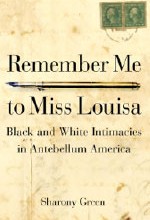Remember Me to Miss Louisa: Black-White Intimacies in Antebellum America (2015)
Author
Summary Some of the women in question appear to have been “fancy girls,” enslaved women sold for use as prostitutes or “mistresses.” Green focuses on women who appear to have been the latter, recognizing the problems with the term “mistress,” given its shifting meaning even during the antebellum period. Remember Me to Miss Louisa moves the life of the fancy girl from New Orleans, where it is typically situated, to the Midwest. The manumission of these women and their children occurred as America’s frontiers pushed westward, and urban life followed in their wake. Indeed, Green’s research examines the tensions between the urban Midwest and the rising Cotton Kingdom. It does so by relying on surviving letters, among them those from an ex-slave mistress who sent her “love” to her former master. This relationship forms the crux of the first of three case studies. The other two concern a New Orleans young woman who was the mistress of an aging white man, and ten Alabama children who received from a white planter a $200,000 inheritance (worth roughly $5.1 million in today’s currency). In each case, those freed people faced the challenges characteristic of black life in a largely hostile America. While the frequency with which Southern white men freed enslaved women and their children is now generally known, less is known about these men’s financial and emotional investments in them. Before the Civil War, a white Southern man’s pending marriage, aging body, or looming death often compelled him to free an African American woman and their children. And as difficult as it may be for the modern mind to comprehend, some kind of connection sometimes existed between these individuals. This study argues that such men were hidden actors in freedwomen’s and children’s attempts to survive the rigors and challenges of life as African Americans in the years surrounding the Civil War. Green examines many facets of this phenomenon in the hope of revealing new insights about the era of slavery. http://www.niupress.niu.edu/niupress/scripts/Book/bookresults.asp?ID=745
|






